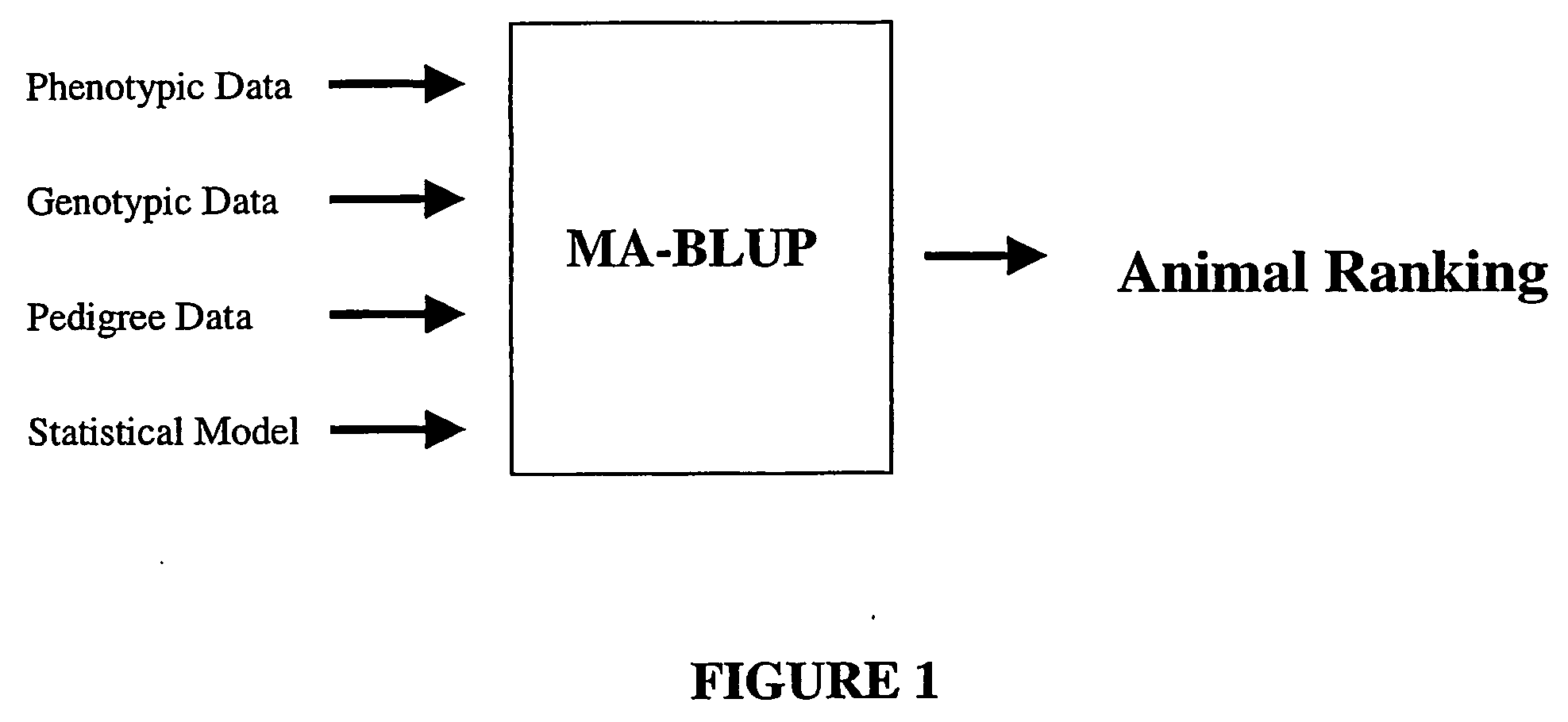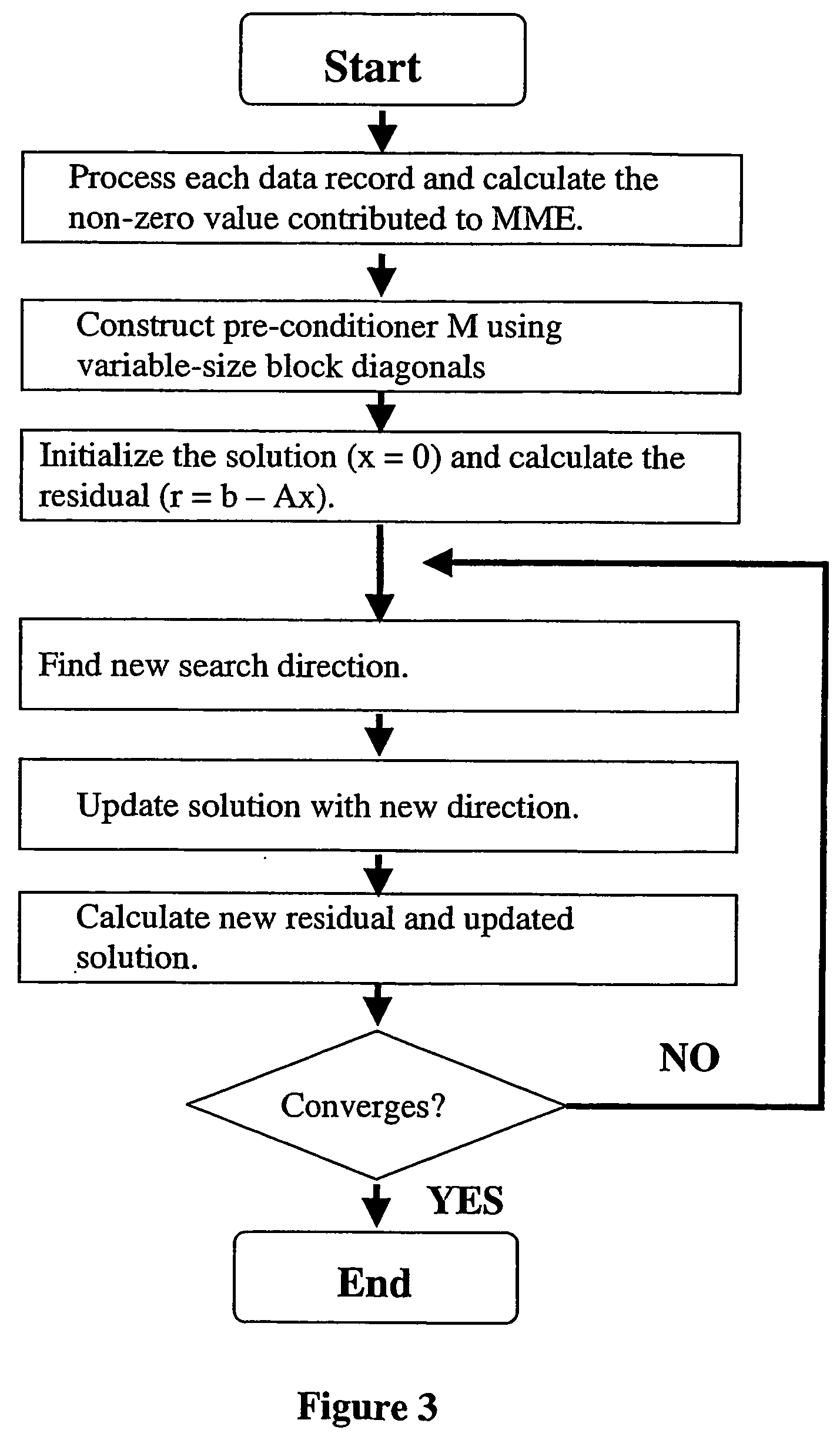Marker assisted best linear unbiased prediction (ma-blup): software adaptions for large breeding populations in farm animal species
a software adaptor and unbiased prediction technology, applied in the field of animal species improvement, can solve the problems of affecting the ability of existing software to incorporate marker information, affecting long-term genetic progress, etc., and achieve the effect of improving the average ebv
- Summary
- Abstract
- Description
- Claims
- Application Information
AI Technical Summary
Benefits of technology
Problems solved by technology
Method used
Image
Examples
example 1
MC4R Maker Marker Used in a Commercial Pig Line A
[0136] From approximately 600 young animals out of a performance testing station the top 10 of males were selected for incorporation into breeding herd to produce the next generation of animals.
Phenotypic Dataanimalsexlittercgpagewdaleanp0000001016391M2004790006160109—0000001030745M2004890006164—5520000005010960M20049901721701695000000005010985M20050901721741415360000005010986M20050901721671415150000005010987M20050901721741185450000005011018F20050901721671136010000005011019F20050901721671135150000005011020F20050901721671195520000005011021F2005090172167106546...2220000007490M34789906821541034922220000007494M34789906821541275112220000007497F34789906821541155332220000007498F3478990682154965202220000007499M34790906821541315252220000007501M34790906821541405342220000007503F34790906821541365112220000007505F34790906821541105082220000006486F34796906821521245312220000006487F347969068215280556
[0137]
Genotypic Dataanimalgenotype0009705450992A / G...
example 2
Identification of New SNPs in the PRKAG3 Gene and their Use for Improving EBV for Meat Quality Traits in Swine Herds
[0141] The porcine PRKAG3 gene is expressed exclusively in skeletal muscle and is involved in the regulation of glycogen synthesis. There is now convincing evidence in the art that supports the hypothesis that mutations in this gene affect meat quality traits such as glycolytic potential (GP, is an indicator of the glycogen level in a living animal which is calculated as a total of the total principle compound susceptible to conversion to lactate. GP equals 2 (glycogen+glucose+glucose-6-phosphate)+lactate), pH, drip loss, and purge. At least two different single nucleotide polymorphisms (SNPs) that alter the amino acid sequence of the mature protein have been found in exons for this gene. Moreover, these polymorphisms have been shown to be associated with the meat quality traits listed above.
[0142] For example, there are two separate international patent applications...
example 3
PRKAG3 Marker Used in a Commercial Pig line A′
[0152] Analysis was done on 60 boars coming out of the performance testing station in March, 2003. The top 10 of them were selected for introduction into the breeding herd to produce next generation. Two SNP markers were used in MA-BLUP for the following calculations.
Phenotypic Dataanimaldamsexglinelittercgpcgp3agewdaleanppH00000006280600000000103005F1621597904420152139501—00000004993390000000452451F1521600904420151154502—00000004993400000000452451F1521600904420151132511—00000004993410000000452386F1521601904420151149463—00000004993420000000452386F1521601904420151129454—00000004993430000000452270F1521602904420151137510—00000004993140000000452747F1521603904420150147472—00000004993150000000452747F1521603904420150133487—00000004993160000000452010F1521604904420150145456—00000004993170000000452010F1521604904420150143502—...10700000108471130000056726F16328099042269917214050161010700000108751130000054850F163281090422699172145528634107000001087...
PUM
| Property | Measurement | Unit |
|---|---|---|
| frequency | aaaaa | aaaaa |
| restriction fragment length polymorphism | aaaaa | aaaaa |
| single strand conformational polymorphism | aaaaa | aaaaa |
Abstract
Description
Claims
Application Information
 Login to View More
Login to View More - R&D
- Intellectual Property
- Life Sciences
- Materials
- Tech Scout
- Unparalleled Data Quality
- Higher Quality Content
- 60% Fewer Hallucinations
Browse by: Latest US Patents, China's latest patents, Technical Efficacy Thesaurus, Application Domain, Technology Topic, Popular Technical Reports.
© 2025 PatSnap. All rights reserved.Legal|Privacy policy|Modern Slavery Act Transparency Statement|Sitemap|About US| Contact US: help@patsnap.com



